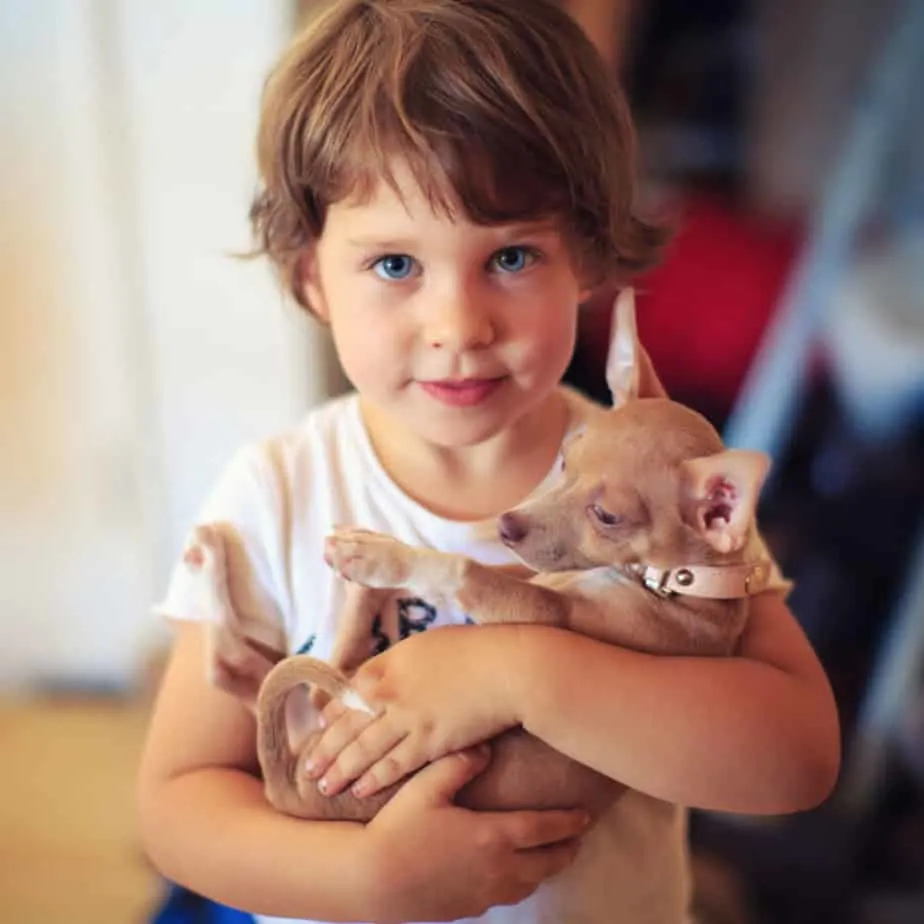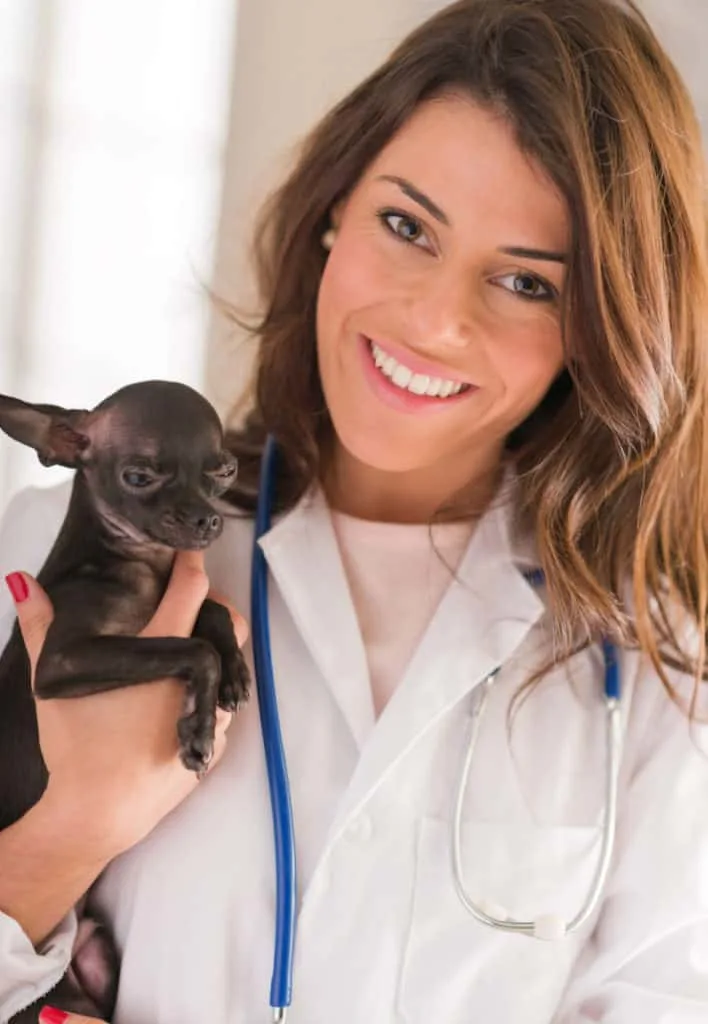Why Socialize Your Puppy?
Puppies who are socialized receive practical benefits such as:
- A socialized dog is more confident. An unsocialized dog is often fearful of new experiences, while a socialized dog has had positive experiences that allow them to enjoy more of life instead of being fearful.
- A socialized dog is usually less likely to bite. Some dogs bite out of fear, which means a dog who is not socialized may become so fearful that he or she feels threatened enough to bite.
- Veterinary care and grooming are less stressful. A dog who is socialized to veterinary exams and grooming will not find them as stressful as a dog who is not.
- Your dog will be able to do more things with you. A socialized dog can go to restaurants with you if you eat on a dog friendly patio, attend dog friendly events, and be welcomed at friend’s homes.
- A socialized dog is more adoptable. The more a dog is socialized to, the more families the dog would be able to thrive in. An unsocialized dog will not be able to be adopted by as many families if they cannot live with certain individuals. For example, a dog who can live with other dogs, cats and children is able to be adopted by more families than a dog who does not like cats and children.

When Should I Socialize My Puppy?
The American Kennel Club (AKC) says that the first 3 month in a puppy’s life are very formative, making socialization crucial from the start. The AKC recommends that socializing puppies should begin with the breeder or rescue group and then continue at home.
How To Socialize Your Puppy
Socializing your puppy requires patience, dedication, consistency and efforts to find good opportunities for socialization. The concept is quite simple:
- Expose your puppy to as many experiences as possible.
- Make all the experiences positive with praise and high value treats.
- Regularly expose your puppy to experiences that he or she will have to help them learn that these events are not stressful.
How to Socialize Your Adult Dog
Adult dogs have had more experience in life than puppies, and sadly, sometimes these experiences are not positive ones. This means that most adult dogs have things that they are comfortable with, and other things that they are fearful of. So if you are adopting an adult dog, you should be prepared to work on socialization to specific things.
Here are tips for overcoming common fears adult dogs may have:
Big, loud, scary trucks!
Some dogs may panic and “pancake” at the sight and sound of the UPS truck, trash truck or school bus. Here is a basic way to work on overcoming these big scary monsters:
- Find a place near the scary truck’s route where you can sit with your dog. Ideally, a front porch or common area near the street, but not near a slatted bench.
- Approximately when the truck will drive by, you will go to your chosen spot with your dog on a standard, not retractable, leash. Act normal and just hang out, petting your dog.
- Have high value treats ready. Start when you hear the truck in the distance, not when the truck is in sight. Ask your dog to sit beside you, “feeding the meter”, giving them treats like you are putting coins into a parking meter.
- Continue to feed the meter when the truck arrives. Ignore the truck; focus on your dog and act as normal as possible.
- Continue doing this as long as you need to until your dog ignores the truck. You may eventually attempt to work up to walking on the sidewalk by the truck, etc.
Veterinarian or Groomer
Some dogs are incredibly anxious to attend appointments with their veterinarian or groomer. If you have a caring veterinarian or groomer who is willing to work with you and your dog, this fear can be handled effectively.
- Start by hanging out in the lobby at a low traffic time for ten to fifteen minutes weekly or once every two weeks. This helps your dog get used to the building and learn that the lobby can just be a place to hang out for a bit with nothing scary associated with it. Ask a receptionist or assistant to come over and pet your dog and talk for a few minutes if they have time; this allows your dog to associate the lobby with positive attention.
- Once your dog behaves comfortably in the lobby, ask to hang out in an exam room or on a grooming table for a few minutes. Simply pet your dog, let them sniff around. Again, if an employee is free to pet your dog, this can help further the association of receiving positive attention at the facility.
- Work up to the employee “examining” your dog by running their hands all over them, checking their ears and paws, brushing them, etc. “Feed the meter”, giving them treats like you are putting coins into a parking meter, during this interaction.
- Continue until your dog becomes comfortable.
Humans, of any age

Dogs may be afraid of men, women, or children in general, or humans wearing hats, or humans of specific ethnicities. You will need a willing volunteer from whoever the anxiety inducing demographic is to work with you and your dog about weekly or once every two weeks.
- Start by having your helper walk into the room where your dog is, then sit on the floor and ignore your dog. They may speak to you or just use their cell phone, but they should completely ignore the dog. Start working in ten to fifteen-minute intervals, increasing to half hour as needed.
- If the dog does not initiate an interaction, the helper should continue ignoring them as well for the duration of the session.
- If the dog chooses to initiate an interaction with the person, let it be on his or her terms. Have the helper sit still, not making sudden movements, allowing the dog to sniff and get as close as he or she feels comfortable to be. Have high value treats ready for the helper to offer the dog. They should place a treat on the floor near them, then with time, offer from their hand outstretched, then hold their hand closer.
- If the dog shows indications of being comfortable enough, have the helper gently and slowly pet the dog. They should not try to pet the top of their head, as a hand going over the head can be intimidating to a dog.
- Gradually work up to the helper acknowledging the dog, walking around the room, initiating the interaction, etc. Have your helper get your dog as used to everything a visitor in your home might do in their presence.
- Continue this exercise until your dog is completely comfortable with allowing the helper to approach and initiate the interaction. Remember that every dog moves at his or her own pace; this may take time.
Other dogs
If your dog is uncomfortable around other dogs and you are not an experienced dog owner, working with a trainer from the start may be helpful. Below I will describe a good starting point to work from. You will need a very dog friendly dog and an experienced dog owner handling the dog to help you. If it does not go well, arranging for the assistance of a trainer is likely the best option going forward.
- Find a securely fenced area, chain link style for visibility, such as a tennis court, basketball court, or playground. Bring your dog into the fenced area and the friendly helper dog will remain outside. With both dogs on leash, walk the perimeter of the fence with the dogs walking parallel to the fence, yours inside and the helper outside. Do this a few times, casually talking to the handler as you would if walking with a friend.
- If both dogs seem relaxed or ignore each other, you may exit the fenced area and go for a walk with a few feet of distance between the dogs. Do this on a few different occasions so that they can get used to each other.
- If both dogs continue to be relaxed or ignore each other, you may slowly start walking closer together. Keep both dogs on leash to separate them if necessary.
- If both dogs continue to be relaxed or ignore each other, you can work up to allowing them off leash in a securely fenced area together.
- Continue this exercise until the dogs can be near each other on a walk or off leash in a securely fenced area. If no progress is made, you might consider enlisting the assistance of different dog friendly dog helper and a dog trainer.
Socialization Tips

Keep the following tips in mind as you socialize your puppy or adult dog:
- Start with a puppy training class. A polite puppy will be able to interact with more people and go to more places, so starting with obedience training should be your first step. A puppy class taught by a reputable, experienced and ethical trainer is also a good environment to socialize your puppy to other dogs and people because it should be structured and run in a safe manner.
- Check yourself before you start. If you are not in a good mental state, your dog will pick up on it and it may work against your efforts. If you are very anxious, your dog will interpret that as a valid reason for them to be anxious as well. This means that if you need to socialize your dog to something that you are uncomfortable with, you need to be comfortable first. If you need to attend therapy to overcome your fear, do that before you begin socializing, or do not hesitate to seek the assistance of a professional dog trainer.
- Do it right the first time. It is much simpler to socialize a dog properly the first time than have to retrain them to overcome a bad experience. If you see an opportunity for socialization that you are not comfortable with or unsure of, it is better to skip it.
- Keep it short and sweet. When attempting to expose a dog to something that he or she is unsure of, the best way to normalize that something is in small, positive doses. Over time you will work up to longer doses, but sometimes it takes baby steps to get there if it is a really scary thing.
- Be an advocate for your dog. It can take only one bad experience to traumatize your dog enough to necessitate serious training to overcome a fear. No one knows your dog like you do, so if you see your dog becoming anxious or overwhelmed, it is time to end the interaction. Or, if you see someone mistreating your dog, step in immediately. Your dog is not a teddy bear and it is not reasonable to expect him or her to tolerate rough handling.
- Read your dog’s body language. Observe your dog’s body language as you attempt to socialize him or her. If you notice signs of anxiety, aggression or fear, it is in everyone’s best interest to end the interaction. Pushing a dog past their limit can result in trauma to the dog or a bite out of fear.
- Take a “trip to a casino”. You may be surprised to learn that dogs are gamblers! During training, you use lots of treats to teach certain behaviors. Over time, your dog will continue to respond to a command even without a reward every time because they think that one is coming. To keep this mindset, you will need to continue providing your dog’s reward of choice, however, you will offer it every other time at first, then every two or three times thereafter. The same “enabling the gambler concept” may benefit a dog working on socialization.
- Create a scavenger hunt. Since the goal of socializing a puppy is to expose them to a variety of things, the American Kennel Club (AKC) recommends making a game out of it, scavenger hunt style.
- Celebrate every win, no matter how small! If you dog is usually terrified of something and shows even a slight improvement, that is cause to celebrate! Any step in the right direction should be rewarded because that is how a journey begins; with one step in the direction of the end goal.
- Do not be afraid to seek professional assistance. If you have attempted to socialize your dog to a certain element consistently and no progress has been made over a long-term period, consider hiring a reputable dog trainer. If the trainer cannot make progress, discuss the circumstances with your veterinarian; your dog may qualify for anxiety medication which may make enough of a different to help complete the socialization. Depending on the input of the trainer and veterinarian, some dogs may not ever be able to overcome something. You may need to be prepared to accommodate your dog’s needs.
Conclusion
By taking the time to properly socialize your dog, you are preparing him or her to enjoy as much of their life as possible. A well socialized dog also makes your life simpler in that you do not have to take as many precautions as the parent of an unsocialized dog would, allowing your dog to participate in more of your life with you.
Be sure to get our free puppy socialization check list!
What were the easiest things to socialize your puppy or dog to? What was the hardest? How did you overcome the hard things? Please share your experiences in the comments below to help other pet parents.
Recommended Reading:
- How to Teach Your Dog to Come to You
- 10 Ways to Reward Your Dog for Good Behavior
- 4 Best Tips For Training Your New Chihuahua
- How to Help a Timid Chihuahua
- What I Wish I had Done Differently with my Chihuahua Puppy


